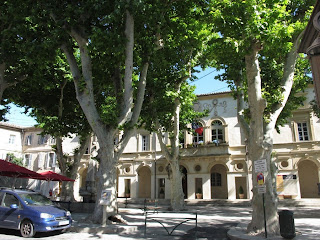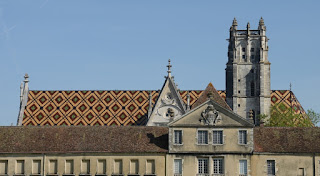The tourist train parked outside the cathedral in Bourges.
Cathedral of St. Etienne in Bourges.
Detail of one of the 13thC stained glass windows.
The diamond pattern is very typical of the half timbered buildings in Bourges.
One of the pretty restaurants in Sainte-Ceneri-le-Gerai, one of the most beautiful villages in France.
A street in Sainte-Ceneri-le-Gerai.
Frescoes probably from the 12th-14thC inside the 11thC Romanesque church in Sainte-Ceneri-le-Gerai. They had been plastered over centuries ago and this preserved them.
Lassay les Chateaux in Mayenne
The story of Sees cathedral and its vicissitudes through the centuries.
The keep of the chateau of Carrouges near Sees in Normandy. The chateau itself is moated and was lived in by the same family from the 14thC until 1936.
On Wednesday we went back to
Falaise to see William the Conqueror's castle where he was born in 1029.
It was drizzling rain, but the old buildings outside the castle were
attractive. Unfortunately at this point the Sat Nav gave up the ghost.
Although previously we have found our way around France with just paper
maps, you do get used to modern technology. We returned to Caen and
found the Opel dealer who was not very helpful and so we resorted to our
own TomTom which we had brought from Australia. Driving north east from
Caen we reached the coast at Deauville, a very up market seaside
resort. Apparently it was race day as there was no shortage of horse
floats and traffic. Our last stop on the way to Rouen was Honfleur, one
of Monet's haunts. Unfortunately it was chaotic. There were major
roadworks and one of the main parking areas was inaccessible. It was
also one of the few places where we found tourist hordes.
A chaumiere - a thatched cottage of Normandy. Although this one does not they typically have iris planted along the ridge of the roof.
The harbour at Honfleur as painted by Monet and many others.
The porch of the wooden St Catherine's church in Honfleur.
A saxophonist plays Bach next to the organ in St Catherine's church in Honfleur.
I love the lively horses on this carousel next to the harbour in Honfleur.
Camembert in the making?
The cliffs at Pourville. I had read how Monet was fascinated by the changing colour of the sea on the Normandy coast. The day we were there, the sea was a beautiful turquoise colour.
Cathedral square surrounded by pleached trees.
Monet's garden at Giverny viewed through the fence.
Sunlight on the cliffs beside the Seine near Les Andelys.
A pigeonnier or dovecote in the Seine Valley. The pigeons were an important food source in Medieval times and were kept for their eggs, meat and dung.
We arrived home to bitterly cold weather and now I have caught up on sleep I will put this blog into hibernation until next time we set off on our travels.


































































